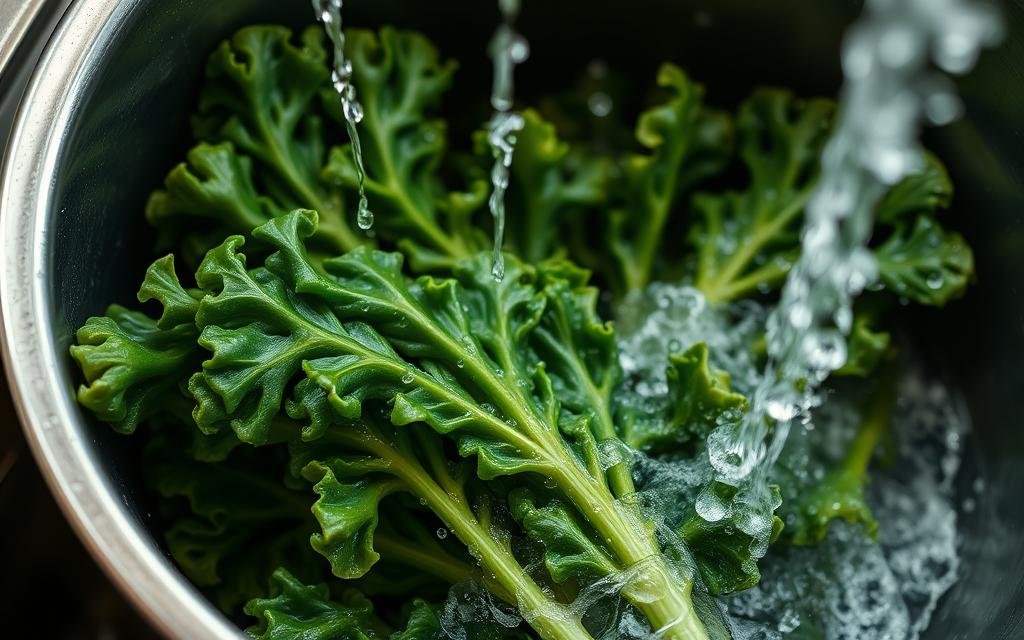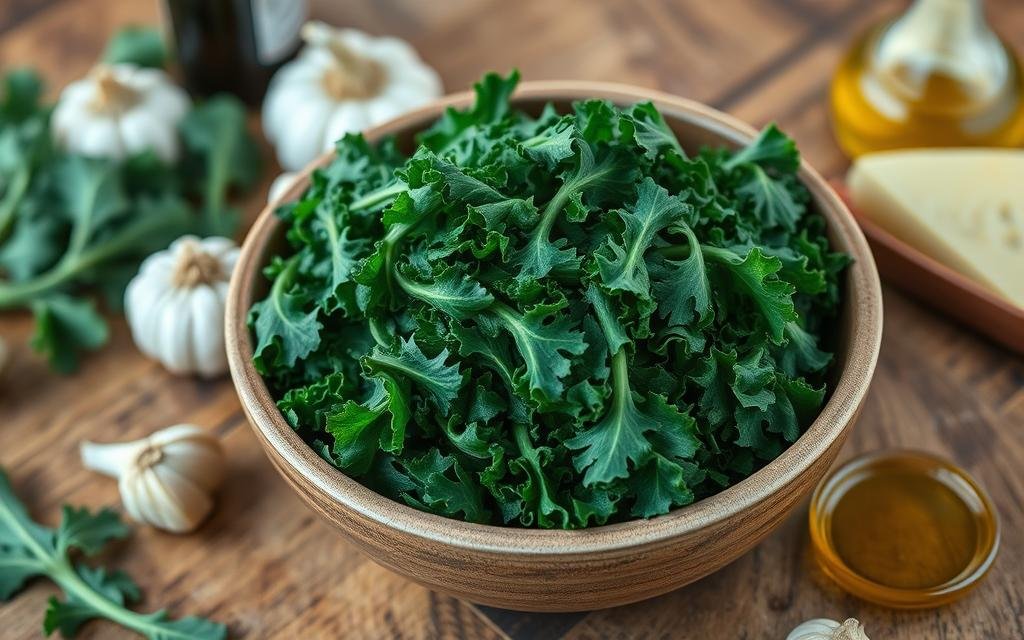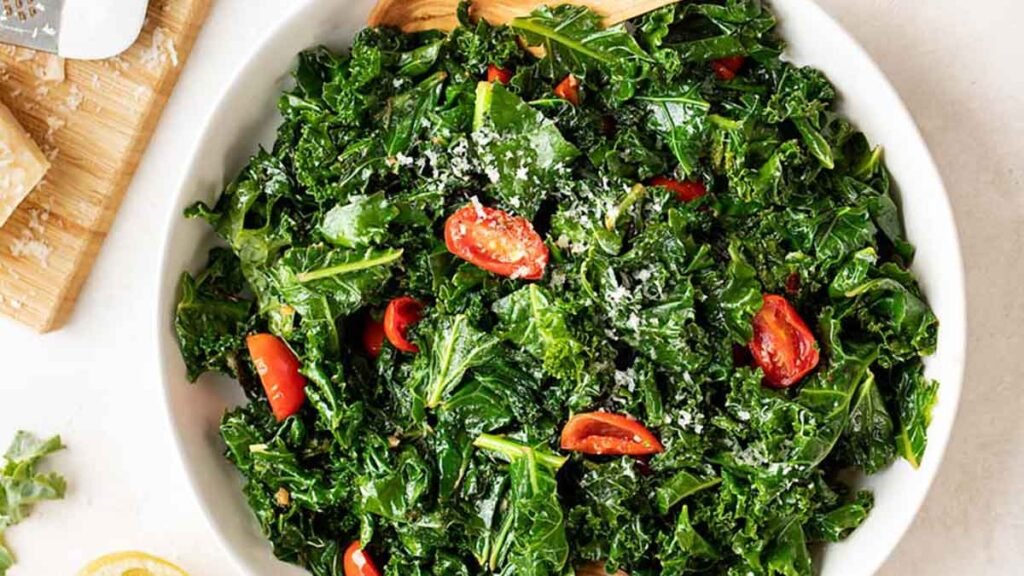The smell of sautéed garlic and olive oil fills your kitchen, taking you to a sunny Tuscan hillside. Cooking a traditional Italian kale recipe connects you with centuries of culinary knowledge. This leafy green, once simple, is now a celebrated superfood, linking ancient traditions with modern health.
Tuscan kale is more than just an ingredient; it’s a symbol of the lasting power of simple, healthy food. When you massage the leaves, you’re following a ritual that Italian grandmothers have done for years. This act is both calming and fulfilling.
The rise of kale in Italian food isn’t just a passing trend; it’s a return to heritage. From old farmhouses to modern restaurants, kale dishes are becoming more popular. They mix nutrition with tradition, showing that old things can become new again. Let’s see how this ancient green is coming back in Italian kitchens worldwide.
The History of Kale in Italian Cuisine
Kale has been a key part of Italian cooking for centuries. It has moved from ancient traditions to modern dishes. In the Tuscan region, it’s especially important.
Ancient Roman Origins
The Romans first grew kale in Italy. They loved it for being tough and full of nutrients. They took it to other parts of Europe as they conquered new lands.
Kale’s Role in Traditional Italian Cooking
Kale was a main ingredient in traditional Italian cooking. In the Tuscan region, a type called lacinato kale was often used. It was great in soups and stews because of its strong taste and texture.
Modern Resurgence of Kale in Italy
Nowadays, kale is back in style in Italian food. Chefs are finding new ways to use Tuscan kale in dishes. From pesto to crispy chips, it’s becoming popular with people who care about health and food lovers.
“Kale is not just a trend, it’s a rediscovery of our culinary heritage,” remarks a renowned Italian chef, highlighting the vegetable’s enduring appeal in Italian gastronomy.

Understanding Different Types of Kale
Kale varieties bring a world of flavors and textures to your Italian dishes. Tuscan kale, also known as lacinato kale, is a top choice in Italian cooking. It has long, dark leaves with a slightly sweet and earthy taste.
Curly kale is another favorite, known for its ruffled leaves and a peppery flavor. It’s great for making crispy kale chips or adding a bite to soups. Red Russian kale has purple stems and frilly edges, offering a milder taste.
When picking kale for your recipes, think about their unique traits. Tuscan kale is great for both raw salads and cooked dishes. Its tender leaves soak up flavors well, making it perfect for traditional Italian recipes.
“Lacinato kale is the secret ingredient in many Tuscan dishes. Its robust flavor and hearty texture elevate simple meals to gourmet status.”
Try different kale varieties to see which you like best. Each type adds its own special touch to Italian cuisine. Whether you pick tuscan kale or another type, you’ll enjoy the rich flavors and health benefits of this versatile green.
Health Benefits of Incorporating Kale into Your Diet
Kale is known as a superfood for good reasons. It’s full of nutrients and health benefits. Adding this versatile vegetable to your meals is a smart choice.
Nutritional Profile of Kale
Kale is a nutritional powerhouse. It’s low in calories but high in vitamins A, C, and K. You’ll also find minerals like calcium and iron in this green gem. One cup of raw kale provides more than your daily need of vitamins K and C.
Antioxidant Properties
The antioxidants in kale protect your body from harmful free radicals. These compounds include beta-carotene, vitamin C, and various flavonoids. Eating kale regularly may lower your risk of certain diseases due to its antioxidants.
Digestive Health Benefits
Kale is an excellent source of fiber, which aids digestion and promotes a healthy gut. The fiber in kale can help you feel full, potentially supporting weight management goals. By adding kale to your meals, you’re boosting your digestive health.
“Kale is not just a trendy superfood. Its impressive nutritional profile and versatility make it a valuable addition to any diet.”
From salads to smoothies, there are many ways to enjoy kale. Try different healthy kale dishes to find your favorite way to add this superfood to your meals.
Italian Kale Recipe: A Classic Tuscan Dish
Tuscan kale, also known as cavolo nero, is the star of this traditional Italian dish. It’s a simple yet flavorful recipe that highlights the versatility of kale in Italian cooking.

– 1 bunch Tuscan kale, stems removed and chopped
– 3 cloves garlic, minced
– 1/4 cup extra-virgin olive oil
– Salt and pepper to taste
– Red pepper flakes (optional)
Begin by washing the kale well. Heat olive oil in a big skillet over medium heat. Add minced garlic and cook until it smells great.
Then, add the chopped kale and stir to coat it with oil. Cook for 5-7 minutes, until the kale is tender but still looks bright green.
Season with salt, pepper, and red pepper flakes if you like. This easy recipe lets the natural taste of Tuscan kale shine. Serve it as a side dish or mix it into pasta for a filling meal.
“In Tuscany, we believe the simplest recipes often yield the most delicious results.”
This Italian kale recipe is both tasty and healthy. It’s a great way to start exploring Tuscan kale and can quickly become a favorite among kale side dishes.
Preparing Kale for Italian Cooking
Learning how to prepare kale is crucial for making tasty Italian dishes. We’ll look at key cooking methods to highlight your kale in any recipe.
Washing and De-stemming Techniques
Begin by washing your kale under cold water. Then, pull out the tough stems by holding the base and pulling. This makes sure your kale is clean and ready for cooking.
Massaging Kale for Tenderness
For salads, massaged kale is ideal. After washing, coat the leaves with olive oil and a bit of salt. Massage it for 2-3 minutes until it becomes soft and green. This makes the kale tender and easier to eat.
Blanching vs. Raw Preparation
Blanching means boiling kale briefly and then cooling it in ice water. This keeps its color bright and its nutrients intact, while making the leaves softer. It’s great for soups and sautés. For salads and pesto, use raw kale. Pick the best method for your recipe to get the best flavor in Italian cooking.
“Kale’s versatility shines through various cooking techniques. Experiment to find your favorite method!”
Pairing Kale with Other Italian Ingredients
Italian cuisine is full of ingredients that go great with kale. Think about mixing this leafy green with classic Italian tastes. Garlic and olive oil make a great base. Sun-dried tomatoes add a sweet tang that goes well with kale’s earthy flavor.
For a filling side dish, try adding white beans to your kale. They bring protein and a nice texture. Pancetta or prosciutto can add a savory taste, balancing out kale’s slight bitterness. Pine nuts or walnuts add a crunchy richness to your dishes.
Adding cheese can take your kale dishes to the next level. Pecorino Romano or Parmigiano-Reggiano grated on top brings a salty, umami taste. For creaminess, use mascarpone or ricotta. These soft cheeses blend well with kale’s strong flavor.
“Kale’s versatility shines when paired with Italy’s finest ingredients. It’s a canvas for culinary creativity.”
Don’t overlook herbs and spices. Rosemary, thyme, and red pepper flakes can turn simple kale dishes into tasty Italian treats. Try these out to make your own unique kale recipes that celebrate Italian cooking traditions.
Creative Variations on Traditional Italian Kale Recipes
Italian cuisine is full of tasty kale recipes. Let’s check out some new spins on classic dishes that highlight this healthy green.
Kale Pesto Pasta
Make your pasta healthier with kale pesto. Mix kale leaves, garlic, pine nuts, olive oil, and Parmesan cheese for a bright sauce. Add it to your favorite pasta for a fast, nutritious meal. It’s great for busy weeknights.
Crispy Kale Chips with Italian Herbs
Turn kale into a tasty snack with an Italian twist. Cut kale into small pieces, brush with olive oil, and add dried oregano, basil, and grated Pecorino Romano. Bake until crispy for kale chips that are just as good as potato chips.
Tuscan Kale and White Bean Soup
Warm up with a hearty Tuscan soup. Cook kale, cannellini beans, carrots, and Italian sausage in a rich broth. This soup is a top pick in vegetarian kale recipes and is great for cold nights.
These new takes on traditional Italian kale dishes add excitement to your meals. Whether you want pasta, snacks, or soup, these recipes are tasty ways to add kale to your diet. Give them a try and find your new favorite kale dish!
Similar Italian Recipes
Italian cuisine is full of dishes with leafy greens. If you like kale recipes, you’ll find these vegetarian kale recipes and kale side dishes great. Let’s check out some tasty alternatives that show Italy’s love for greens.
Sicilian Pasta with Broccoli Rabe is a tasty dish that goes well with kale. It mixes bitter greens, garlic, and red pepper flakes for a zesty taste. You can change broccoli rabe with kale in this recipe for a new twist on traditional Italian dishes.
Ribollita, a hearty Tuscan soup, is perfect for kale fans. This vegetarian soup combines cannellini beans, bread, and various veggies, including kale. It’s a comforting meal that captures the spirit of Italian home cooking.
For a quick and easy side dish, try Sautéed Escarole. This green tastes a bit bitter, like kale. Cook it with garlic, olive oil, and lemon for a simple yet tasty side dish.
Try these Italian recipes to broaden your cooking skills and find new ways to add healthy greens to your meals. Each dish brings a unique flavor while honoring the rich traditions of Italian cuisine.
Conclusion
Italian kale recipes have been around for ages, proving its worth beyond just being a trend. From ancient Roman times to today’s Tuscan kitchens, kale has always been a key ingredient. It’s versatile, making dishes like kale pesto pasta and crispy kale chips a hit.
Kale is a superfood full of nutrients and antioxidants. Eating it can improve your health. Adding kale to your meals means you’re eating tasty food that’s also good for you.
We suggest you try making healthy kale dishes at home. Whether it’s a traditional Tuscan kale soup or a new recipe, you’ll be part of a long culinary tradition. So, pick up some kale and start cooking. Your taste buds and body will love this superfood.
FAQ
What is the history of kale in Italian cuisine?
Kale has been a part of Italian cooking since ancient Roman times. It was a key ingredient in traditional Italian meals. Today, chefs love it for its versatility and health benefits.
What are the different types of kale used in Italian cooking?
In Italian recipes, you’ll find two main types of kale. Tuscan kale, also called lacinato kale, has long, thin leaves. Curly kale has leaves that are tightly packed and ruffled.
Why is kale considered a superfood?
Kale is full of vitamins, minerals, and antioxidants. It’s low in calories but rich in fiber, vitamin A, C, K, iron, and calcium. These nutrients help keep you healthy and feeling good.
How do you prepare kale for Italian cooking?
To get the most out of kale in Italian dishes, start by washing it well and removing the stems. Massage the leaves with olive oil or lemon juice to make them tender. Briefly blanching or cooking can also soften them.
What are some creative variations on traditional Italian kale recipes?
Get creative with kale by adding it to pesto pasta, making crispy kale chips with Italian herbs, or using it in hearty soups. These ideas show how versatile kale is in Italian cooking.
What other Italian recipes pair well with kale?
Kale goes great with many Italian ingredients like tomatoes, garlic, beans, pasta, and cheeses like Parmesan or pecorino. It’s perfect for side dishes, soups, pasta, and more, adding nutrition and flavor to any meal.



